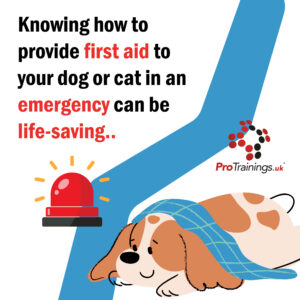Pet First Aid: How to Care for Your Dog or Cat in Emergencies
Our pets are beloved family members, and just like humans, they can encounter emergencies that require immediate attention. Knowing how to provide first aid to your dog or cat in an emergency can be life-saving. This guide covers essential pet first aid tips, ensuring you’re prepared to care for your furry friends most when they need you.
1. Assessing the Situation
Before jumping into action, it’s important to calmly assess the situation:
- Stay Calm: Your pet will pick up on your emotions, so staying calm will help keep them calm too.
- Safety First: Ensure the environment is safe for both you and your pet. Move your pet away from any dangers, like traffic or harmful objects.
- Check for Vital Signs: Look for signs of breathing, a pulse, and responsiveness. If your pet is unresponsive, you may need to perform CPR.
2. Performing CPR on Dogs and Cats
CPR can be life-saving if your pet is unresponsive and not breathing:
- Step 1: Check for Breathing and a Pulse: Place your hand on your pet’s chest, just behind the front legs. If there’s no pulse and your pet isn’t breathing, start CPR immediately.
- Step 2: Position Your Pet: Lay your pet on their right side on a flat surface.
- Step 3: Chest Compressions: For medium to large dogs, place your hands over the widest part of the chest. For small dogs or cats, use one hand to compress the chest. Perform 30 compressions at a rate of 100-120 compressions per minute.
- Step 4: Rescue Breaths: After 30 compressions, close your pet’s mouth and breathe into their nose until you see the chest rise. Give two rescue breaths.
- Step 5: Continue: Alternate between 30 chest compressions and 2 rescue breaths until your pet starts breathing or help arrives.
3. Dealing with Bleeding
If your pet is bleeding, it’s important to control the bleeding quickly:
- Apply Pressure: Use a clean cloth or bandage to apply firm pressure to the wound.
- Elevate the Limb: If possible, raise the injured limb above the level of the heart to reduce blood flow.
- Secure the Bandage: Once the bleeding is under control, wrap the wound with a bandage. Ensure it’s not too tight, as this can cut off circulation.
- Seek Veterinary Care: Even if the bleeding stops, take your pet to the vet as soon as possible for a thorough examination.
4. Choking Hazards
Pets are naturally curious and can easily choke on small objects, toys, or food:
- Signs of Choking: If your pet is choking, they may paw at their mouth, gag, or make choking noises. Their gums may also turn blue due to a lack of oxygen.
- Remove the Object: If you can see the object, try to remove it carefully with tweezers or your fingers. Be careful not to push it further down the throat.
- Heimlich Manoeuvre: If you can’t remove the object, you may need to perform the Heimlich manoeuvre. For small pets, place them on their back and apply firm pressure to the abdomen just below the ribcage. For larger pets, stand behind them, wrap your arms around the abdomen, and give a quick, upward thrust.
- Visit the Vet: Even if you successfully remove the object, it’s important to have your pet checked by a vet.
5. Treating Burns
Burns can occur from heat, chemicals, or electricity:
- Cool the Burn: Immediately cool the burned area with cold water for at least 20 minutes.
- Cover the Burn: Gently cover the burn with a clean, non-stick bandage or cloth.
- Avoid Ointments: Do not apply ointments, butter, or creams to the burn.
- Seek Veterinary Care: Burns can cause significant damage, so it’s essential to have your pet examined by a vet as soon as possible.
6. Managing Poisoning
Pets can accidentally ingest harmful substances, including household cleaners, plants, or human medications:
- Identify the Poison: If possible, determine what your pet has ingested and how much.
- Do Not Induce Vomiting: Do not attempt to make your pet vomit unless instructed by a vet, as this can sometimes cause more harm.
- Contact Your Vet or Animal Poison Control: Call your vet immediately or contact an animal poison control centre. Provide as much information as possible, including the substance and your pet’s size and weight.
- Follow Instructions: Follow the vet’s or poison control centre’s instructions carefully. You may be advised to bring your pet in immediately for treatment.
7. Handling Seizures
Seizures can be frightening, but there are steps you can take to help your pet:
- Stay Calm: Keep calm and avoid panicking.
- Prevent Injury: Clear the area around your pet to prevent them from injuring themselves during the seizure. Do not try to restrain them.
- Time the Seizure: Note the length of the seizure. If it lasts longer than 5 minutes, or if your pet has multiple seizures in a row, seek
emergency veterinary care. - Comfort Your Pet: After the seizure, comfort your pet and keep them quiet. They may be disoriented or confused.
Conclusion
Being prepared for pet emergencies with basic first aid knowledge can make a critical difference in your pet’s well-being. While first aid can help stabilise your pet, it’s always important to seek professional veterinary care as soon as possible. Consider taking a pet first aid course to further improve your skills and ensure you’re ready to handle any situation that may arise with your beloved furry friend.
Our main pet first aid site has more information on training and you can find pet first aid kits on our store.

